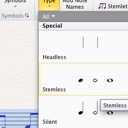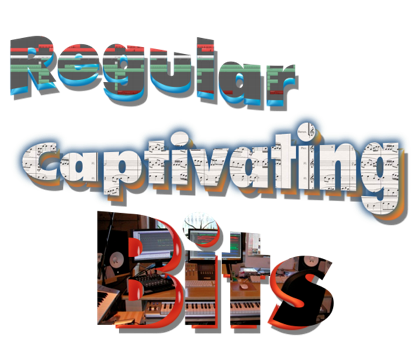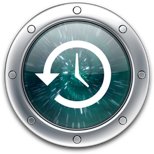Tips and Tricks
Writing free rhythm in Sibelius at macProVideo.com
07/11/11 21:21

My newest article at macProVideo.com will tell you how to notate free rhythm in Sibelius 7. So please go to the macProVideo.com Hub and read for yourself!
Comments
Regular Captivating Bits - now live!
27/03/11 17:20
The previously announced „Regular Captivating Bits“ section is now live!
There I post tips, tricks and lots of other things about composition, orchestration, arrangement and many more topics. I quote myself from the announcement: For me, helping each other is an important thing. I believe in learning by doing and I think that you should never stop learning new things. I regularly help people out with quick tips which - according to them - have made their life easier. So why not share all this with you! There are lots of little tips and tricks that can make you a better composer or artist.
I hope you like it. The page will be updated very frequently. You can also subscribe to the RSS feed to stay up-to-date.
Using several notation applications for mockups at macProVideo.com
16/03/11 10:34

Quite often when time is flying, it is necessary to create audio demos from your scores very quickly. You just don’t have the time to do a proper mockup in Logic or Cubase.
I have found combining exports of several notation applications to be a good compromise between speed and quality. See for yourself at macProVideo.com!
Regular Captivating Bits - Starting Soon!
06/03/11 19:19

Soon I will start a new section on the tutorials page called „Regular Captivating Bits“, where you will find all sorts of quick tips, hints and lots of other stuff. Basically, this will be the place for everything I want to tell you which does not fit on this blog. This page will be updated quite often, with the tips coming from every aspect of music production you can imagine: composition, orchestration, arrangement, business, software tips, links to great resources and many, many more things!
Watch this space so you don’t miss it when the „Regular Captivating Bits“ go live!
Reinstalling OSX made easy at macProVideo.com
24/01/11 14:54
As my post on good backups at macProVideo.com seemed to be quite useful to a lot of people, I want on writing a sequel.
The new tutorial, which has just been published is about the day when you need to reinstall OSX and how this process can be made as painless as possible.
So have a look at it at macProVideo.com!
The new tutorial, which has just been published is about the day when you need to reinstall OSX and how this process can be made as painless as possible.
So have a look at it at macProVideo.com!
Backup tips at macProVideo.com
24/12/10 12:15
The christmas elves are never sleeping... a present for you:
Right on Christmas Eve, here’s another tutorial at the macProVideo blog. This time, I’ll help you set up backups and find out where all those Logic files are located on your system.
Head over to the macProVideo blog and check it out.
Right on Christmas Eve, here’s another tutorial at the macProVideo blog. This time, I’ll help you set up backups and find out where all those Logic files are located on your system.
Head over to the macProVideo blog and check it out.
Blogging at macProVideo.com
09/09/10 16:48
I am pleased to announce that my first blog post at the macProVideo.com blog just went online.
You will learn about how to use the grouping tag in iTunes. I will continue blogging there about iTunes as well as about other applications, so make sure you drop by and leave a nice comment :)
I am pretty happy to have the chance to blog there - if you haven’t already, also check out their great video tutorials about all things mac.
You will learn about how to use the grouping tag in iTunes. I will continue blogging there about iTunes as well as about other applications, so make sure you drop by and leave a nice comment :)
I am pretty happy to have the chance to blog there - if you haven’t already, also check out their great video tutorials about all things mac.
Pro Tools Rig for Cheap
06/05/10 10:15
UPDATE:
Since the original post, Avid has released Pro Tools 9, which no longer requires a Digidesign/M-Audio interface! You can now use any audio interface with PT, so some of the information in this post is outdated. The general way of using your slave with a second audio interface still holds true, though, only you can now choose whichever interface you like.
This is sort of an idea for all those monetary challenged people out there (like me), who nonetheless want to have a Pro Tools rig at their disposal.
As you might know, we use Logic Pro as our Main DAW, a choice which we are pretty happy with, but which sometimes leads to format problems, i.e. when we need to work on films for making the soundmix. The industry standard in this area is Pro Tools. But Pro Tools is sooooooooo expensive. No, it isn’t. Pro Tools HD is. But there’s more.
If you have your project ready as a Pro Tools file, with a certain certainty everyone can open it. You might know that there are cut-down versions of PT, namely LE and M-Powered. Besides the name, there is _no_ difference between LE and M-Powered and with Version 8 the differences to Pro Tools HD have shrunk, too. For most projects, an LE or M-Powered rig is absolutely sufficient. LE only runs with Digidesign audio interfaces, M-Powered only runs with M-Audio interfaces (hence the name).
The really cool thing is that LE or M-Powered can open PT HD projects and vice versa! That means, for most projects you can easily use a LE rig (i.e. for sound mixing and film post pro) and then give the whole thing to a large mastering house for the final touch.
LE and M-Powered are both very affordable and are a very good way into the world of Pro Tools. While we firmly believe in Logic for composing and recording, for post-production there’s just nothing better than PT.
Ok, so now we know that PT can be pretty affordable, but it gets even better!
You need a computer to run it on, right? Well, what about a nice slave PC that sits around in the corner if you are not composing with your template right at the moment? Right!!!
We fortunately had an old M-Audio interface lying around unused, so what we did was to hook it up to our Dell Slave which usually hosts our composing template and installed PT M-Powered. That way, when the Slave PC is not used for its slave labour, it serves as a PT rig.
To make this kind of „second DAW“ as pleasant to use as possible, there are a few nice things you can do:
- The PT rig can use the big studio monitors by connecting the audio interface’s SPDIF Out with a SPDIF In of the interface of the main machine. No sound quality is lost and you can additionally use the DSP power of your main machine! And you don’t need any additional gear.
- Master keyboards usually have both an USB output as well as a MIDI output. One of these can be hooked up to the slave = you can use PT to record MIDI data.
- Euphonix Artist controllers can control several workstations at the same time. If your main DAW is a Mac (as in our case) you can use it as a EuCon server, even if your second computer runs Windows. This is undocumented, but it works. Just install the Windows workstation drivers from the Euphonix website and make sure there’s a network connection between the Mac and the PC (there will be automatically one if you are using VE Pro on the slave). Then you can use the controller to control Pro Tools or any other DAW on the PC.
- If you log into the slave with Microsoft Remote Desktop or another RDC client (we use CORD), then you don’t even need a keyboard and mouse on the slave. Just tuck it somewhere safe where it is out of the way and noone will ever see there’s _yet_ another rig there :)
All this gives you a perfect Pro Tools rig, which can use all your studio hardware, including MIDI keyboards and hardware controllers!
And all you need to invest in is an audio interface (if you don’t already have one) and a license for PT.
Hope this helps :)
Since the original post, Avid has released Pro Tools 9, which no longer requires a Digidesign/M-Audio interface! You can now use any audio interface with PT, so some of the information in this post is outdated. The general way of using your slave with a second audio interface still holds true, though, only you can now choose whichever interface you like.
This is sort of an idea for all those monetary challenged people out there (like me), who nonetheless want to have a Pro Tools rig at their disposal.
As you might know, we use Logic Pro as our Main DAW, a choice which we are pretty happy with, but which sometimes leads to format problems, i.e. when we need to work on films for making the soundmix. The industry standard in this area is Pro Tools. But Pro Tools is sooooooooo expensive. No, it isn’t. Pro Tools HD is. But there’s more.
If you have your project ready as a Pro Tools file, with a certain certainty everyone can open it. You might know that there are cut-down versions of PT, namely LE and M-Powered. Besides the name, there is _no_ difference between LE and M-Powered and with Version 8 the differences to Pro Tools HD have shrunk, too. For most projects, an LE or M-Powered rig is absolutely sufficient. LE only runs with Digidesign audio interfaces, M-Powered only runs with M-Audio interfaces (hence the name).
The really cool thing is that LE or M-Powered can open PT HD projects and vice versa! That means, for most projects you can easily use a LE rig (i.e. for sound mixing and film post pro) and then give the whole thing to a large mastering house for the final touch.
LE and M-Powered are both very affordable and are a very good way into the world of Pro Tools. While we firmly believe in Logic for composing and recording, for post-production there’s just nothing better than PT.
Ok, so now we know that PT can be pretty affordable, but it gets even better!
You need a computer to run it on, right? Well, what about a nice slave PC that sits around in the corner if you are not composing with your template right at the moment? Right!!!
We fortunately had an old M-Audio interface lying around unused, so what we did was to hook it up to our Dell Slave which usually hosts our composing template and installed PT M-Powered. That way, when the Slave PC is not used for its slave labour, it serves as a PT rig.
To make this kind of „second DAW“ as pleasant to use as possible, there are a few nice things you can do:
- The PT rig can use the big studio monitors by connecting the audio interface’s SPDIF Out with a SPDIF In of the interface of the main machine. No sound quality is lost and you can additionally use the DSP power of your main machine! And you don’t need any additional gear.
- Master keyboards usually have both an USB output as well as a MIDI output. One of these can be hooked up to the slave = you can use PT to record MIDI data.
- Euphonix Artist controllers can control several workstations at the same time. If your main DAW is a Mac (as in our case) you can use it as a EuCon server, even if your second computer runs Windows. This is undocumented, but it works. Just install the Windows workstation drivers from the Euphonix website and make sure there’s a network connection between the Mac and the PC (there will be automatically one if you are using VE Pro on the slave). Then you can use the controller to control Pro Tools or any other DAW on the PC.
- If you log into the slave with Microsoft Remote Desktop or another RDC client (we use CORD), then you don’t even need a keyboard and mouse on the slave. Just tuck it somewhere safe where it is out of the way and noone will ever see there’s _yet_ another rig there :)
All this gives you a perfect Pro Tools rig, which can use all your studio hardware, including MIDI keyboards and hardware controllers!
And all you need to invest in is an audio interface (if you don’t already have one) and a license for PT.
Hope this helps :)

